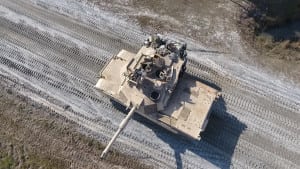
Mounting the Trophy active protection system (APS) on an M1 Abrams results in a net increase in weight of about half a ton to the already 73-ton tank, but achieves a vehicle survivability level that only an unacceptably heavy amount of traditional armor could provide.With Trophy installed “you are protected against a broader range of threats,” Maj. Gen. David Bassett told reporters last week during a media day at Aberdeen Test Center, Md. “Everybody talks about losing weight with active…

 By
By 











